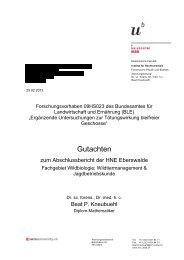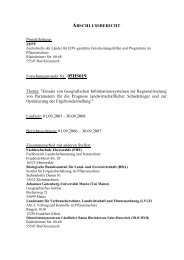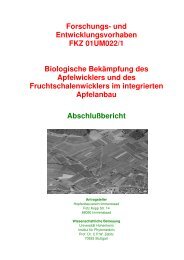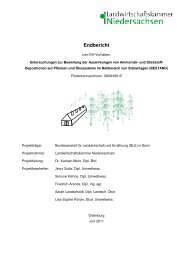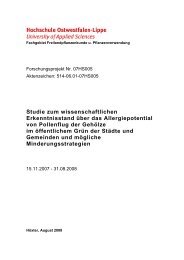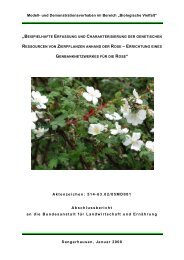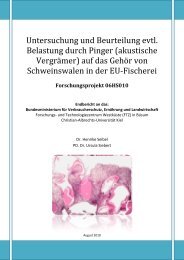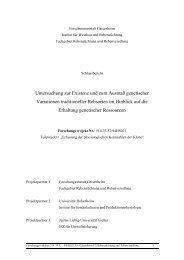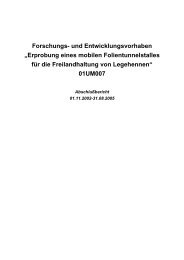Abschlussbericht Projekt: „Verminderung der ... - BLE
Abschlussbericht Projekt: „Verminderung der ... - BLE
Abschlussbericht Projekt: „Verminderung der ... - BLE
Erfolgreiche ePaper selbst erstellen
Machen Sie aus Ihren PDF Publikationen ein blätterbares Flipbook mit unserer einzigartigen Google optimierten e-Paper Software.
Blackspot bruise formation in potato (Solanum tuberosum) tubers in relation<br />
to the components determining tuber specific gravity<br />
Antje Wulkow 1 , Elke Pawelzik 1 , Rolf Peters 2 , Norbert U. Haase 3<br />
1 Quality of Plant Products Section, Department of Crop Sciences, University of Goettingen,<br />
Germany; 2 VSD-Research Station Dethlingen, Germany; 3 Max-Rubner-Institute,<br />
Detmold, Germany<br />
Abstract<br />
Table potato (Solanum tuberosum) tubers with a range of specific gravities from 1.095 kg L -1 from a three years field experiment were investigated. Genetic and environmental<br />
factors had little influence on the development of tubers with different specific<br />
gravities. To a greater extend the accumulation of dry matter and water during different<br />
phases of tuberization determined the specific gravities of mature tubers of one cultivar or<br />
plant. Mechanical impacts on harvested and stored potato tubers initiated blackspot bruise<br />
formation. Inconsistent results occurred in many reports if intracellular membrane rupture<br />
is necessary to form blackspot bruise or not. The presented results showed that blackspot<br />
bruise formation might occur without membrane rupture because cell necrosis or cell<br />
deaths were not detected. Thus presented findings compared to literature outcomes showed<br />
that mechanical impact on potato tubers led to open mechanosensitive channels of intracellular<br />
membranes, and therefore to blackspot bruise formation without intracellular membrane<br />
rupture.<br />
Keywords: dry matter, starch content, pectin<br />
Introduction<br />
Table potatoes are consumed worldwide, while their acceptance as food differs due to regional<br />
habits. Additionally, convenience food becomes more accepted rather than nonprocessed<br />
tubers (Haase 2008). This trend is noticed all over the world, especially in<br />
Europe and North America where 20 to 50 % of the daily potato consumption consist of<br />
processed tubers. The quality of these products depends on the available raw potato tubers<br />
and therefore on growing conditions as well as harvesting, handling and storage operations<br />
(Keijbets 2008). These procedures enhance the possibility to damage potato tubers mechanically<br />
resulting in blackspot bruise, which is known to reduce tuber quality and therefore,<br />
its utilization. Since many years the reduction of blackspot bruise susceptibility of<br />
potato tubers is a topic of interest of scientific research. Tuber impact susceptibility include<br />
bruise threshold and bruise resistance. Bruise threshold is the impact at which blackspot<br />
occurs and bruise resistance is defined as the ratio of bruising energy to the resulting bruise<br />
volume (van Eck 2007). Blackspot describes a dark discolouration of the cortical parenchyma.<br />
After impact phenols, primarily monophenols like tyrosine and/or diphenols like<br />
chlorogenic acid un<strong>der</strong>go a series of oxidative reactions initiated by the copper containing<br />
194




